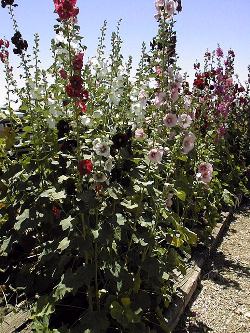Sunset®: All zones
USDA: 4-10
Frost Tolerance: Hardy in Phoenix
Sun Exposure: Full sun to part sun
Origin: Eastern Mediterranean
Growth Habits: Annual in Phoenix, tall spikes of flower reaching 9 feet (2.7 m) for some varieties
Flowers: White, light yellow, yellow, light orange, pink, red or purple flowers, up to 6 inches wide (15 cm.), in late spring to late summer
Watering Needs: Regular water
Propagation: Seeds in late summer or spring

Growing 4 to 8 feet high, hollyhocks are an old garden standard, particularly useful for background screening or where vertical accent is desired. They grow best in full sun in deep, rich, well drained soils.
Linnaeus, who named this plant, used both Alcea (Latin form) and Althea(Greek form) from the Greek word for 'to cure'
Blooming Habits:
Some varieties act as reseeding biennials. Annual types are available that flower the first year. Single, semi-double or double flowers, white, yellow, pink, apricot, red, purple to almost black, 3 to 6 inches in diameter (7.5 to 15 cm).
Culture:
Avoid soils that are too rich. Check for rust and spider mites.
Propagation:
Sow in September for spring bloom. Protect the seedlings from snails and slugs. They can also be sown indoor at 50-55°F (10-12°C)
Desert-Tropicals is dedicated to provide gardening advice, gardening ideas, and information about flower of all kind for landscape and collections.We try to check carefully the identification of the plants on the illustrations as well as the other information from the page, but occasionally errors do occur. if you notice anything that needs to be changed please contact us.Thanks.
© 1998-2020 Philippe Faucon, All Rights Reserved.
